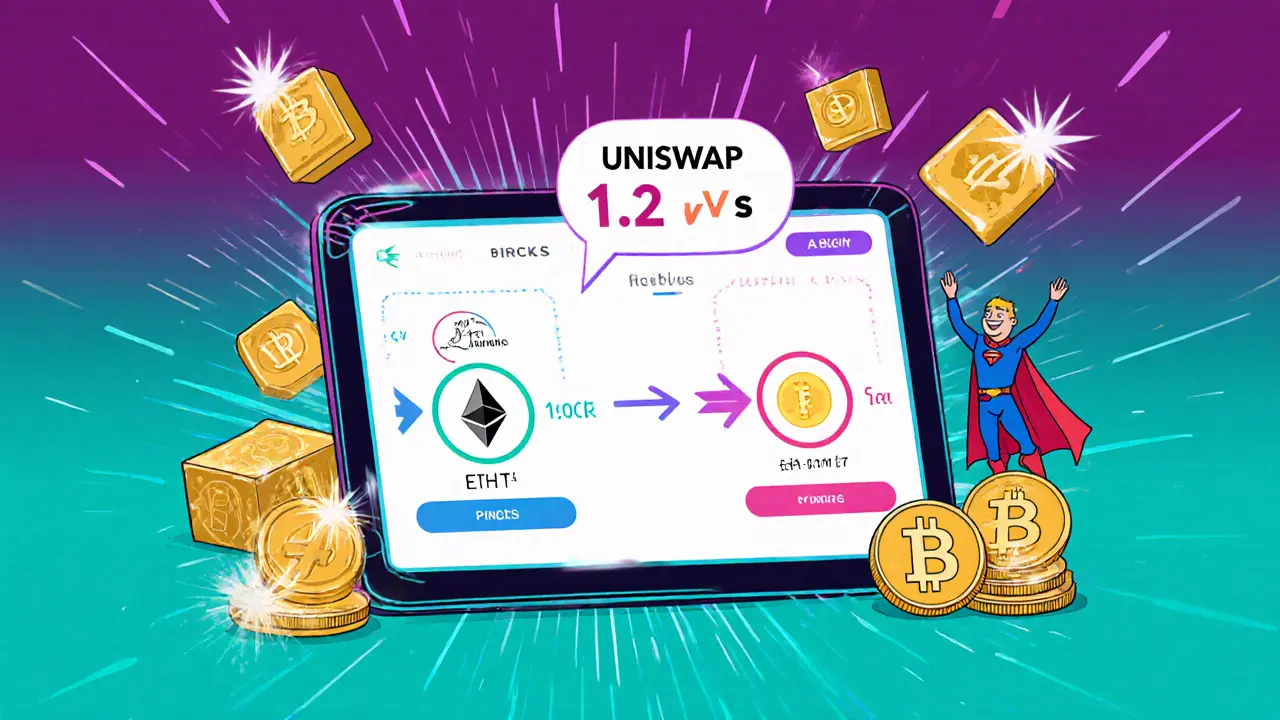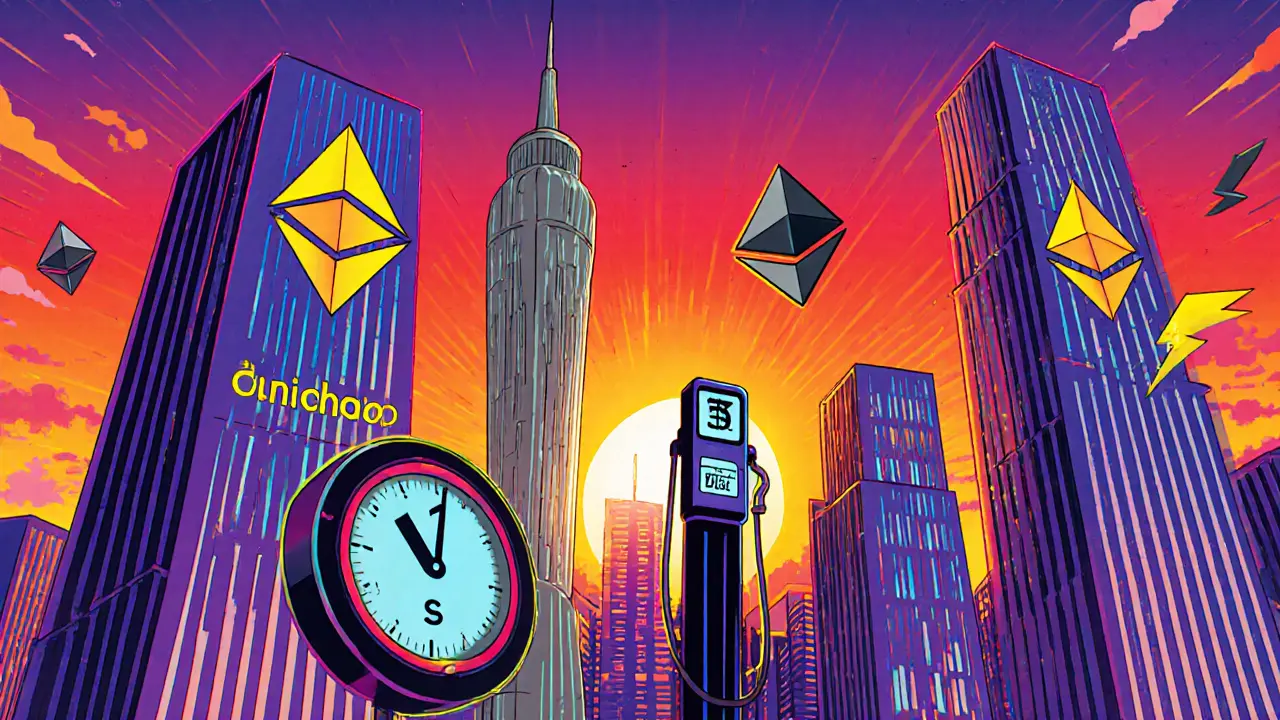Unichain Fee Calculator
Calculate how much you'd save using Unichain compared to Ethereum L1 transactions. Unichain offers 95% cheaper fees with 1-second block times.
Example: An Ethereum transaction costing $0.03 would cost only $0.0015 on Unichain, saving you $0.0285 (95% less).
Quick Summary
- Unichain delivers ~1‑second block times and 95% cheaper fees than Ethereum L1.
- Integrates tightly with Uniswap v3, letting liquidity providers earn higher APRs.
- Built on Optimism’s OP Stack, but focused exclusively on DeFi.
- Current limits: younger security track record, central sequencer until Q3 2025.
- Roadmap points to 250 ms blocks, full decentralization via the UVN, and Superchain interoperability.
What is Unichain?
Unichain is a purpose‑built Ethereum Layer 2 blockchain launched by Uniswap Labs in November 2024. It uses an Optimistic rollup architecture, runs the full EVM, and targets DeFi‑heavy workloads. The official blog described it as “a new home for DeFi” designed to crush gas fees and latency that have limited on‑chain trading.
Unichain sits beside Ethereum’s mainnet, inheriting security through fraud proofs while offering cheaper, faster settlements. Its adoption is driven by the Uniswap Interface, which automatically flips to the Unichain network when users select the “Unichain” chain.
How Unichain powers Uniswap v3
Uniswap v3 is the third iteration of the automated market maker protocol launched in May 2021. It introduced concentrated liquidity, multiple fee tiers, and advanced pricing curves.
When you trade on Uniswap v3 via the Unichain network, the same smart contracts run, but they settle on a Layer 2 that processes a block roughly every second. This means a trade that would cost $0.03 on Ethereum might cost $0.0015 on Unichain, while completing in under 1.2 seconds.
The UNI token governs the Unichain Validation Network (UVN) and stakes to secure the rollup, aligning token holders with the network’s health.
Technical specs and performance
Unichain’s stack rests on the Optimism OP Stack, a modular framework that lets developers swap components like data availability or consensus. Key performance figures (Feb 2025 data):
- Average block time: 1 second (target 250 ms after Rollup‑Boost upgrade).
- Gas fee: $0.0015 per transaction - roughly 95 % lower than Ethereum L1.
- Transaction throughput: >2 million daily swaps, representing ~18 % of Uniswap’s total volume.
Two technologies drive these numbers:
- Rollup‑Boost compresses calldata and reduces proof generation time, shrinking effective block time to a quarter‑second.
- Flashblocks (planned for Q2 2025) leverages trusted execution environments to pre‑order transactions, cutting latency further.
Unichain also supports ERC‑7683, a universal cross‑chain token standard co‑developed with Across, smoothing asset movement between Unichain and other L2s.

User experience: fees, speed, liquidity
Early adopters on Reddit reported swapping 5 ETH for UNI in 1.2 seconds with a $0.0018 fee - a ten‑fold speed boost over mainnet. Liquidity providers noted APR jumps from ~12 % on Ethereum to 18.5 % on Unichain for the same ETH/USDC pool, thanks to lower fee drag.
On‑ramping is handled by USDC via Coinbase’s Onramp service, making fiat‑to‑crypto entry frictionless. The Uniswap Interface automatically detects the Unichain network, so users only need to add the RPC details (Chain ID 13000, RPC URL https://mainnet.unichain.org, native currency UNI) once.
Trustpilot scores for the Uniswap Interface on Unichain hover at 4.3/5, with praise focusing on transaction speed and low fees. The main complaints revolve around a narrower token list compared to Ethereum and occasional wallet sync hiccups.
Comparison with other Layer 2 solutions
| Layer 2 | Block time | Gas fee (vs. ETH $0.03) | DeFi focus | Central sequencer? |
|---|---|---|---|---|
| Unichain | 1 s (target 250 ms) | $0.0015 (≈95 % lower) | Yes - built for Uniswap v3 | Yes (until UVN Q3 2025) |
| Arbitrum One | 0.5‑2 s | $0.0024 (≈92 % lower) | General purpose | No (decentralized) |
| Optimism | 2 s | $0.0024 (≈92 % lower) | General purpose | No |
| StarkNet | 5‑10 min (zk‑rollup) | $0.0018 (≈94 % lower) | Broad | No |
| zkSync Era | 5‑10 min | $0.0017 (≈94 % lower) | Broad | No |
The table shows Unichain’s sweet spot: near‑instant finality and DeFi‑specific tooling, at the cost of a temporary central sequencer and a smaller dApp ecosystem.
Risks and limitations
Because Unichain launched only in late 2024, its security history is short. The Stage 1 rollup relies on a sequencer that can eventually be challenged, but full decentralization only arrives after the UVN rollout. Analysts like Samczsun caution that early‑stage L2s may face “trust assumptions” that could deter risk‑averse institutions.
Liquidity is still concentrated; while Unichain pulls Uniswap’s own pools, many ERC‑20 tokens are unavailable compared with Ethereum mainnet. Users also face a 7‑day withdrawal challenge period when moving funds back to L1, similar to other Optimistic rollups.
Regulatory uncertainty adds another layer of risk. The SEC’s early‑2025 guidance hints that L2 networks could be treated differently from L1 chains, but the exact implications for Unichain’s governance token (UNI) remain unsettled.

Future roadmap and outlook
Uniswap Labs has a busy 2025 agenda:
- Q2: Deploy TEE‑based block building, cutting effective block time to ~250 ms.
- Q3: Launch the Unichain Validation Network (UVN), enabling anyone to run a validator node.
- Late 2025: Enable native Superchain interoperability, allowing single‑block message passing across the Optimism ecosystem.
- 2026 horizon: Explore Verkle tree integration for lighter state proofs.
Market forecasts are bullish. Arcane Research projects $5.2 billion TVL by year‑end 2025, up from $1.8 billion in February 2025. Delphi Digital notes that Unichain’s focused DeFi mandate fills a genuine niche, even if it never rivals general‑purpose L2s in raw dApp count.
Getting started & troubleshooting
1. Add the network in your wallet (MetaMask, Trust Wallet, etc.) using the parameters: Chain ID 13000, RPC URL https://mainnet.unichain.org, Symbol UNI.
2. Open the Uniswap Interface, switch the network selector to “Unichain,” and connect your wallet.
3. Swap, add liquidity, or stake as you would on Ethereum. Fees will appear in the UI as a fraction of a cent.
If a transaction fails:
- Check RPC latency - Unichain’s node selection can affect 1‑second block confirmation.
- Verify you have the correct Chain ID; many support tickets (≈35 %) stem from a typo.
- For withdrawal delays, remember the 7‑day challenge period; you can expedite by paying a small “fast‑exit” fee (currently $2 on Unichain).
Uniswap’s help centre rates documentation 4.5/5 for clarity, and the community Discord (24.5k members) offers live assistance during office hours.
Frequently Asked Questions
What makes Unichain different from other Layer 2s?
Unichain is built exclusively for DeFi and tightly integrates with Uniswap v3. Its 1‑second block time and 95 % fee reduction beat most L2s, while the Rollup‑Boost upgrade aims for 250 ms finality.
Do I need a special wallet to use Unichain?
No. Any Ethereum‑compatible wallet (MetaMask, Trust Wallet, Coinbase Wallet) can connect by adding the Unichain RPC details.
How safe are my funds on Unichain?
Security relies on Optimistic rollup fraud proofs and, after Q3 2025, the decentralized UVN. While still newer than Arbitrum or Optimism, audits and bug‑bounty programs are in place.
Can I move assets back to Ethereum mainnet?
Yes. Use the “Bridge” button in the Uniswap Interface. Withdrawals incur a 7‑day challenge period, but a fast‑exit option is available for a small fee.
What’s the future of Unichain’s token governance?
The UNI token will continue to power the UVN staking and governance proposals, allowing the community to vote on upgrades like Superchain interoperability.

Write a comment